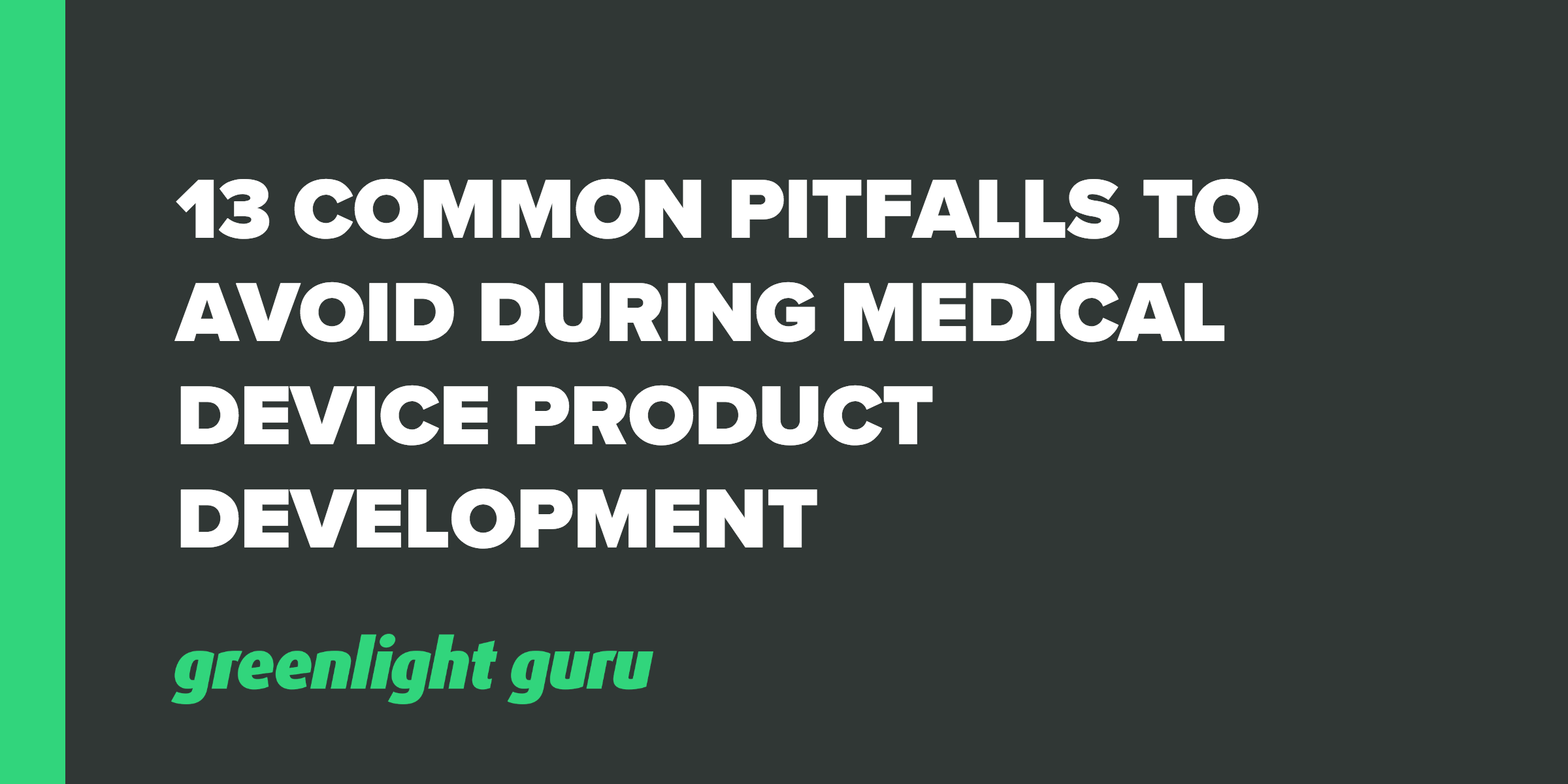13 Common Pitfalls to Avoid During Medical Device Product Development

Are you falling into some of the common traps that surround medical device product development?
In our 20+ years of experience in the industry, we’ve seen a lot of mistakes, but often, it’s the same common set of pitfalls repeated across different companies.We’ve come up with 13 (unlucky for some) common pitfalls that we still see happening in medical device development. These are in no particular order of severity, so take a queue from the mistakes of others and set your company up to avoid them:
1. Forgetting about the user
This mistake is particularly irksome as you're forgetting the main reason why you’re developing a product. Failing to include the user in the process often starts right at the beginning of the development process.
A common practice that we’ve seen is to feel that your users are smart enough to figure it out themselves, then months down the track, you have users asking, “what is this?!”
Ideally, you want to have the user involved in the process of documenting user needs from the beginning.
2. Failing to document design controls or DHF
Sometimes developers get so focused on the end goal that they forget about the process and don’t capture or document what they should. Your design controls and design history file are often casualties of this tendency, and the thought is often “we’ll catch that up later.”
The problem is that development can move so fast that you can’t even remember what it is that you should have documented. It’s difficult to catch up the documentation after the fact so it’s really not a good idea to attempt it. Your design controls and DHF are among the four “musts” of a QMS.
3. Delaying implementing your Quality Management System
Piggy backing on the previous mistake, it’s never a good plan to delay setting up your QMS. You need some basic, core procedures and a good process right from the beginning.
A QMS is a basic requirement and you can expect that FDA or the relevant regulatory authority you’re dealing with will want to examine it in an inspection. You don’t need to go overboard; in fact, we often speak about bootstrapping and how to get through with a minimalist, yet thorough approach. (Check out our Four Medical Device Quality System Musts, you can get by bootstrapping if only you have these in place).
4. Designing for an actual person
This might sound a little strange, but it’s actually something we’ve seen quite often. A common (and big) mistake is to design products or devices for an actual individual person. Sometimes this might work out, but the danger is that you don’t have a decent population of people for whom your device is suitable.
You need to broaden your scope and examine user needs across the population. If you persist with designing for a single person, your chances of success at launch tend to be slim.
5. Not defining regulatory strategies
Alright listen up, if you’ve ever thought along the lines of “oh, this is simple, I don’t have to do a submission to the FDA,” how did that turn out for you? This is a basic, yet common mistake in that developers underestimate the regulatory requirements that they need to follow for their particular device, or they go ahead and take a guess.
For starters, a lot rides on how your product is classified, so you need to have this established early in order to really define your regulatory strategy. (Check out our step-by-step guide to how your device will be classified here).
Classification will be based on your indications for use and in order to classify properly, you will need a clear understanding of these. Your classification will determine how the various regulatory bodies look at your device.
6. Failing to plan
There’s an applicable saying here; “failing to plan is planning to fail.” So often we see companies who think they have a plan because they’ve produced a Gantt chart, but this is not a project plan at all. A Gantt chart is really just a schedule of milestones, not a design and development plan at all.
Related to this is that people also often fail to define a good design and development plan. You need to identify critical interfaces in your project, resources you need, milestones you need to achieve and when you’re going to have design reviews. This is how you ensure that you’re operating in a way that is designed to get your device to market as soon as possible. Know the road that you need to navigate through product development so you can plan accordingly.
7. Rushing your Design Inputs
It’s a big mistake to try rushing through your design inputs. Often, the company is trying to hit some kind of date milestone that they’ve come up with, but rushing can lead to missing vital information or including information that shouldn’t be there.
A rule of thumb that is often talked about in the industry is that design inputs should take up to 30% of your project timeline. The intent behind that is to get good design inputs. The process to get there should be a repetition of prototype, then iterate until you’ve got it right.
8. Having disorganized documentation
You have to keep all of your documentation organized, period. Some companies don’t even have a design history file, or they keep part here and part over there, with the pieces never quite coming together well.
You’ll save yourself untold headaches and possible issues with regulatory if you have a good system of keeping all your documentation organized. Some people start out with paper-based documents, but we’d highly recommend an electronic system. If you’re a startup, you’ll find some of these are huge and complicated, and a bit much for your needs, which is one reason we created greenlight.guru as a solution that is simple to implement, keeps your documents organized and can grow with your needs.
9. Treating risk management as a checkbox Activity...
… if it is done at all. So, this really encompasses two pitfalls with risk management. There are many companies that know it’s something they need to do so they treat it as another item on a checklist that they must check off. You spend a lot of time and energy on it, so make sure you’re getting value out of it!
Use your risk management activities to actually do something meaningful; for example, to improve the safety and efficacy of your device.
The second pitfall is, of course, that there are many companies who don’t look after risk management at all. Just. Do. It.
10. Mismanaging suppliers
There are a few common pitfalls that relate to mismanaging or not taking a close enough look at suppliers. For starters, some companies end up with suppliers who are really not good at their jobs.
There’s often a culmination of mistakes that lead to this, including the device company failing to keep a list of suppliers, not recording supplier terms and information, and failing to monitor, evaluate or qualify the supplier.
You MUST make sure your suppliers are all legitimate and capable of doing what you need them to do. To be extra careful, you may audit them or require inspection activities. Safety and efficacy of the device is always the end objective and of course, suppliers play a big role in this.
11. Not keeping good records
There’s failing to document, but then there’s also documenting things poorly. There is a record keeping element to every aspect we’ve talked about in previous sections and it’s important to do this well.
We see many medical device companies underestimate the importance of good record keeping to the success of the company as a whole. You only have to look at the volume of warning letters and Form 483 from the FDA that relate to poor record keeping and you can begin to see that this can create a lot of unnecessary strife.
12. Abdicating to suppliers
We see this happen where the company whose name goes on the product outsources manufacturing, design, packaging or other aspects of the process. They expect those companies to keep good documentation so that they don’t have to; but ultimately, it is the responsibility of the company whose name is going on the device to maintain records.
FDA expects you to take ownership, so don’t blame your supplier as it won’t go down with them. For example, some of these companies don’t have a device master record of their own because they’re relying on the manufacturer. Yes, of course the manufacturer needs to have documentation, but so do you as the product owner. You need to demonstrate that your records match up with theirs and that you know of any changes that were made.
13. Rushing human testing
It’s common to want to get human study done quickly, but companies often haven’t done a thorough job of safety testing first. It’s disturbing how casually this often seems to be treated; particularly, where the company acts as though using a country with less regulations for testing makes it ok.
You’re using your product on humans! There should be evidence of controls during manufacturing, biocompatibility testing etc., to prove the product is safe first.
These were some of the most common pitfalls we see in medical device product development. If you recognize your company in any of these, it’s probably not too late to make a course correction. We often write about the requirements for medical device development and tips for companies to look out for. Start with out 15 Items Medical Device Companies Must Address, and check out our other guides and resources on our blog.
Still using a manual or paper-based approach to manage your design controls or quality processes? Click here to learn more about how greenlight.guru's modern eQMS software platform exclusively for medical device companies is helping device makers all over the globe in more than 50 countries get safer products to market faster with less risk while ensuring regulatory compliance.
Jon Speer is a medical device expert with over 20 years of industry experience. Jon knows the best medical device companies in the world use quality as an accelerator. That's why he created Greenlight Guru to help companies move beyond compliance to True Quality.









